Education for All: Problems of Quality in China's Education System
VerifiedAdded on 2020/05/28
|17
|4961
|1051
Report
AI Summary
This report provides a comprehensive overview of China's education system, focusing on the challenges and issues related to the quality of education. It examines the education system's structure, including the various levels of education, from preschool to higher education, and discusses the policies implemented to make education accessible to all citizens. The report delves into the problems China faces in providing quality education, such as the shift to English as a medium of instruction, financial investments in remote areas, and compulsory education for migrant students. It also highlights key educational initiatives and regulations, offering recommendations for improvement, such as increased funding for remote areas, teacher training, student loans, and curriculum development. The report concludes that while China has a satisfactory education system under government supervision, continuous efforts are needed to address quality concerns and ensure equitable access to education.
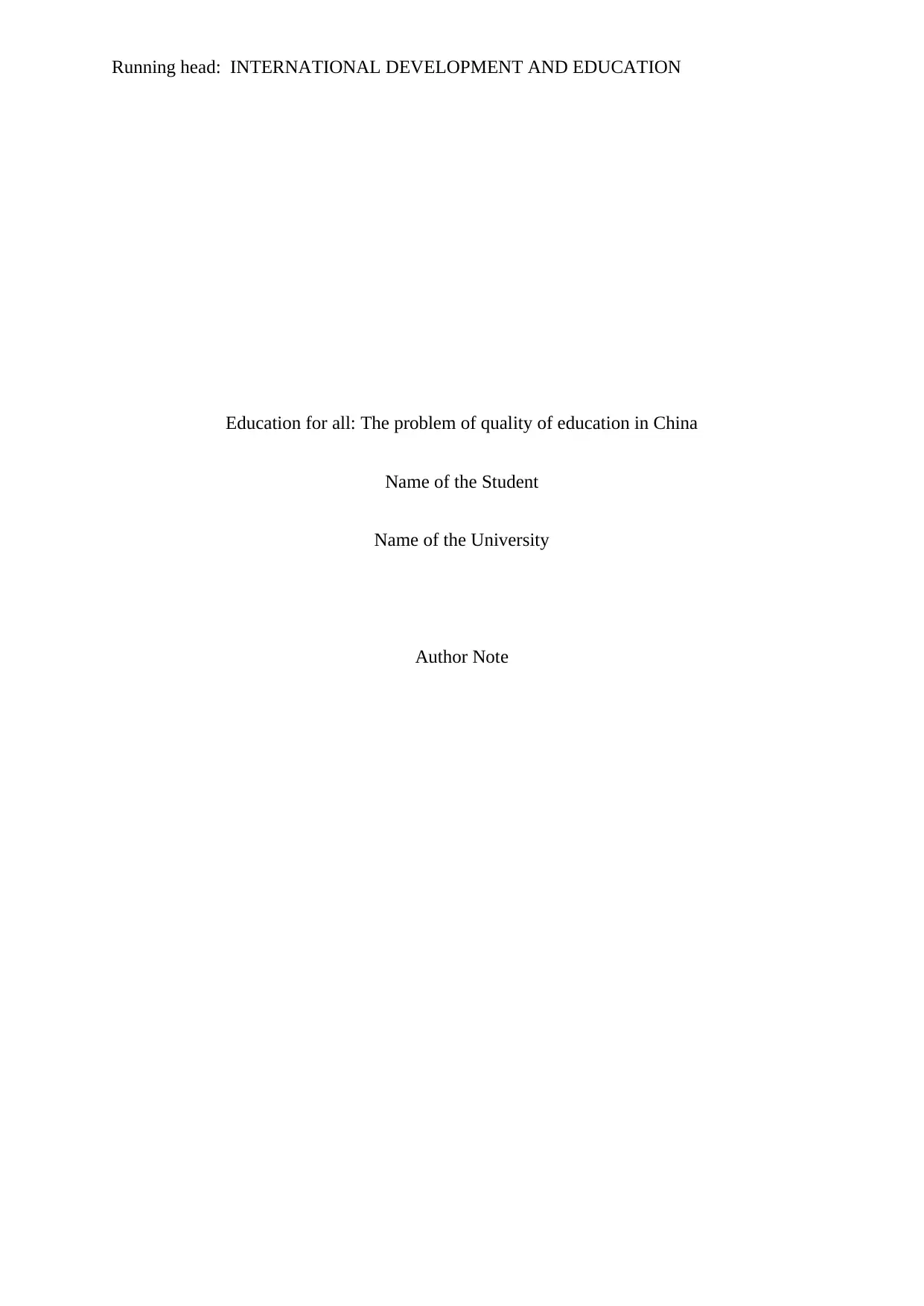
Running head: INTERNATIONAL DEVELOPMENT AND EDUCATION
Education for all: The problem of quality of education in China
Name of the Student
Name of the University
Author Note
Education for all: The problem of quality of education in China
Name of the Student
Name of the University
Author Note
Paraphrase This Document
Need a fresh take? Get an instant paraphrase of this document with our AI Paraphraser
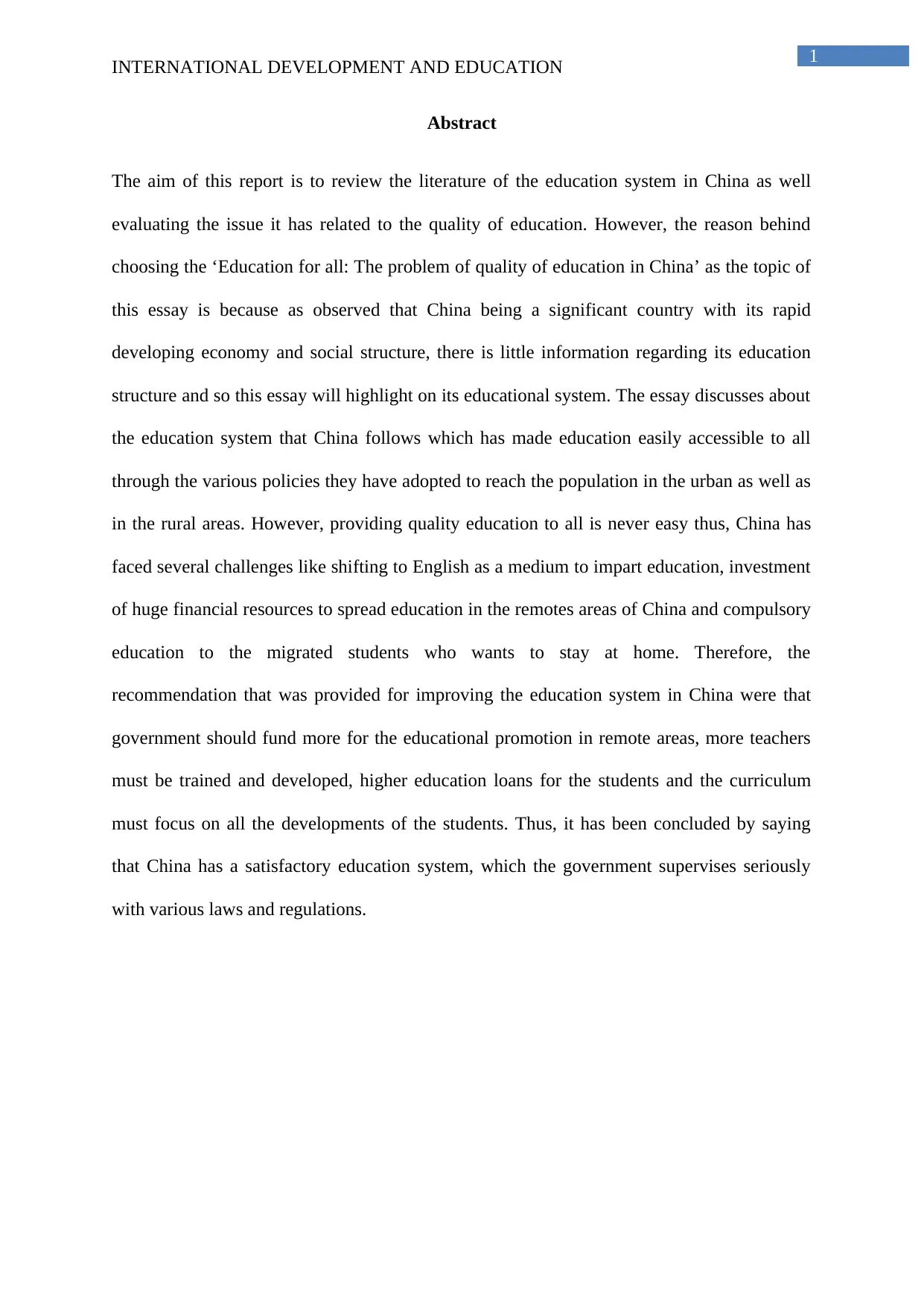
1
INTERNATIONAL DEVELOPMENT AND EDUCATION
Abstract
The aim of this report is to review the literature of the education system in China as well
evaluating the issue it has related to the quality of education. However, the reason behind
choosing the ‘Education for all: The problem of quality of education in China’ as the topic of
this essay is because as observed that China being a significant country with its rapid
developing economy and social structure, there is little information regarding its education
structure and so this essay will highlight on its educational system. The essay discusses about
the education system that China follows which has made education easily accessible to all
through the various policies they have adopted to reach the population in the urban as well as
in the rural areas. However, providing quality education to all is never easy thus, China has
faced several challenges like shifting to English as a medium to impart education, investment
of huge financial resources to spread education in the remotes areas of China and compulsory
education to the migrated students who wants to stay at home. Therefore, the
recommendation that was provided for improving the education system in China were that
government should fund more for the educational promotion in remote areas, more teachers
must be trained and developed, higher education loans for the students and the curriculum
must focus on all the developments of the students. Thus, it has been concluded by saying
that China has a satisfactory education system, which the government supervises seriously
with various laws and regulations.
INTERNATIONAL DEVELOPMENT AND EDUCATION
Abstract
The aim of this report is to review the literature of the education system in China as well
evaluating the issue it has related to the quality of education. However, the reason behind
choosing the ‘Education for all: The problem of quality of education in China’ as the topic of
this essay is because as observed that China being a significant country with its rapid
developing economy and social structure, there is little information regarding its education
structure and so this essay will highlight on its educational system. The essay discusses about
the education system that China follows which has made education easily accessible to all
through the various policies they have adopted to reach the population in the urban as well as
in the rural areas. However, providing quality education to all is never easy thus, China has
faced several challenges like shifting to English as a medium to impart education, investment
of huge financial resources to spread education in the remotes areas of China and compulsory
education to the migrated students who wants to stay at home. Therefore, the
recommendation that was provided for improving the education system in China were that
government should fund more for the educational promotion in remote areas, more teachers
must be trained and developed, higher education loans for the students and the curriculum
must focus on all the developments of the students. Thus, it has been concluded by saying
that China has a satisfactory education system, which the government supervises seriously
with various laws and regulations.
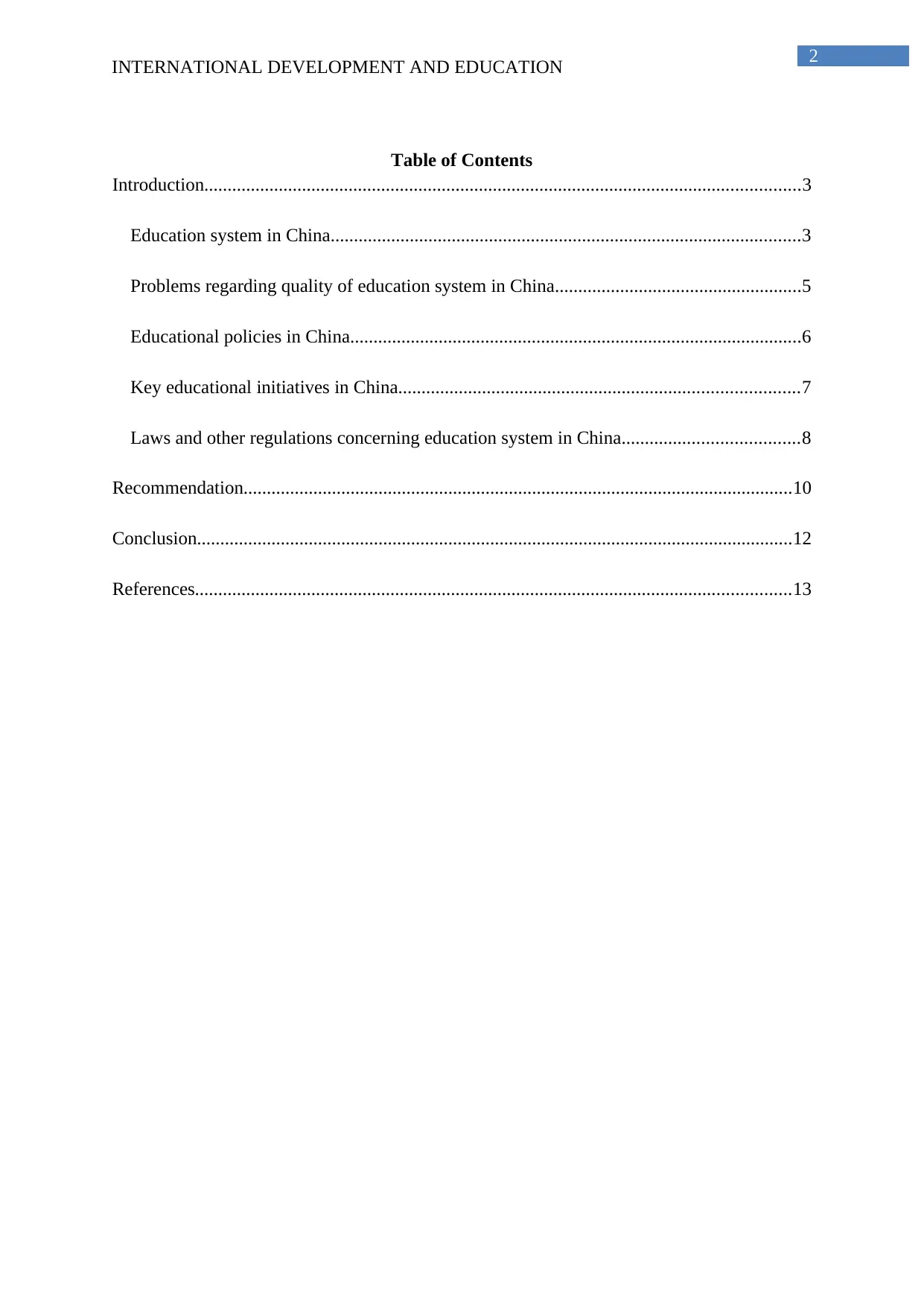
2
INTERNATIONAL DEVELOPMENT AND EDUCATION
Table of Contents
Introduction................................................................................................................................3
Education system in China.....................................................................................................3
Problems regarding quality of education system in China.....................................................5
Educational policies in China.................................................................................................6
Key educational initiatives in China......................................................................................7
Laws and other regulations concerning education system in China......................................8
Recommendation......................................................................................................................10
Conclusion................................................................................................................................12
References................................................................................................................................13
INTERNATIONAL DEVELOPMENT AND EDUCATION
Table of Contents
Introduction................................................................................................................................3
Education system in China.....................................................................................................3
Problems regarding quality of education system in China.....................................................5
Educational policies in China.................................................................................................6
Key educational initiatives in China......................................................................................7
Laws and other regulations concerning education system in China......................................8
Recommendation......................................................................................................................10
Conclusion................................................................................................................................12
References................................................................................................................................13
⊘ This is a preview!⊘
Do you want full access?
Subscribe today to unlock all pages.

Trusted by 1+ million students worldwide
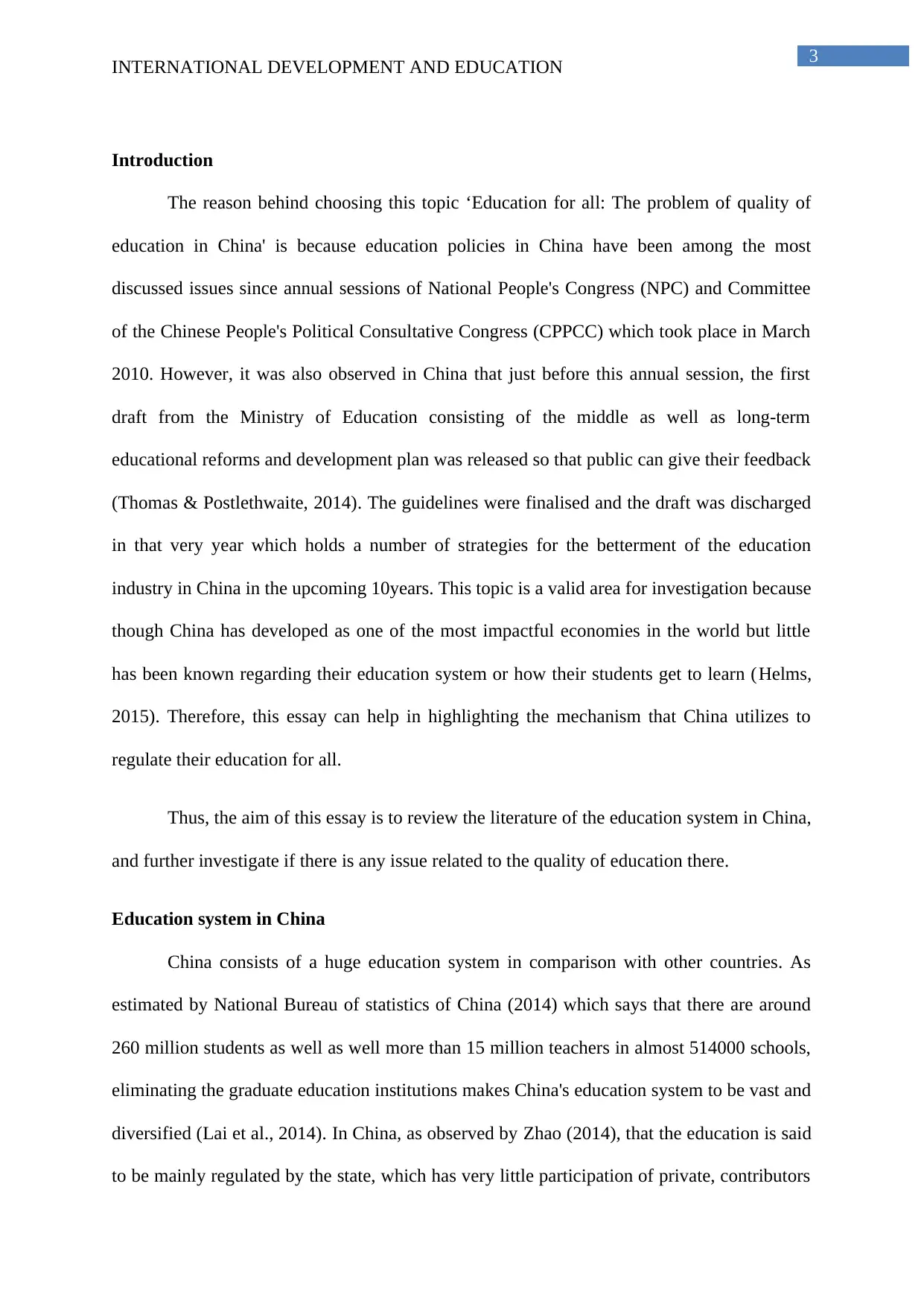
3
INTERNATIONAL DEVELOPMENT AND EDUCATION
Introduction
The reason behind choosing this topic ‘Education for all: The problem of quality of
education in China' is because education policies in China have been among the most
discussed issues since annual sessions of National People's Congress (NPC) and Committee
of the Chinese People's Political Consultative Congress (CPPCC) which took place in March
2010. However, it was also observed in China that just before this annual session, the first
draft from the Ministry of Education consisting of the middle as well as long-term
educational reforms and development plan was released so that public can give their feedback
(Thomas & Postlethwaite, 2014). The guidelines were finalised and the draft was discharged
in that very year which holds a number of strategies for the betterment of the education
industry in China in the upcoming 10years. This topic is a valid area for investigation because
though China has developed as one of the most impactful economies in the world but little
has been known regarding their education system or how their students get to learn (Helms,
2015). Therefore, this essay can help in highlighting the mechanism that China utilizes to
regulate their education for all.
Thus, the aim of this essay is to review the literature of the education system in China,
and further investigate if there is any issue related to the quality of education there.
Education system in China
China consists of a huge education system in comparison with other countries. As
estimated by National Bureau of statistics of China (2014) which says that there are around
260 million students as well as well more than 15 million teachers in almost 514000 schools,
eliminating the graduate education institutions makes China's education system to be vast and
diversified (Lai et al., 2014). In China, as observed by Zhao (2014), that the education is said
to be mainly regulated by the state, which has very little participation of private, contributors
INTERNATIONAL DEVELOPMENT AND EDUCATION
Introduction
The reason behind choosing this topic ‘Education for all: The problem of quality of
education in China' is because education policies in China have been among the most
discussed issues since annual sessions of National People's Congress (NPC) and Committee
of the Chinese People's Political Consultative Congress (CPPCC) which took place in March
2010. However, it was also observed in China that just before this annual session, the first
draft from the Ministry of Education consisting of the middle as well as long-term
educational reforms and development plan was released so that public can give their feedback
(Thomas & Postlethwaite, 2014). The guidelines were finalised and the draft was discharged
in that very year which holds a number of strategies for the betterment of the education
industry in China in the upcoming 10years. This topic is a valid area for investigation because
though China has developed as one of the most impactful economies in the world but little
has been known regarding their education system or how their students get to learn (Helms,
2015). Therefore, this essay can help in highlighting the mechanism that China utilizes to
regulate their education for all.
Thus, the aim of this essay is to review the literature of the education system in China,
and further investigate if there is any issue related to the quality of education there.
Education system in China
China consists of a huge education system in comparison with other countries. As
estimated by National Bureau of statistics of China (2014) which says that there are around
260 million students as well as well more than 15 million teachers in almost 514000 schools,
eliminating the graduate education institutions makes China's education system to be vast and
diversified (Lai et al., 2014). In China, as observed by Zhao (2014), that the education is said
to be mainly regulated by the state, which has very little participation of private, contributors
Paraphrase This Document
Need a fresh take? Get an instant paraphrase of this document with our AI Paraphraser
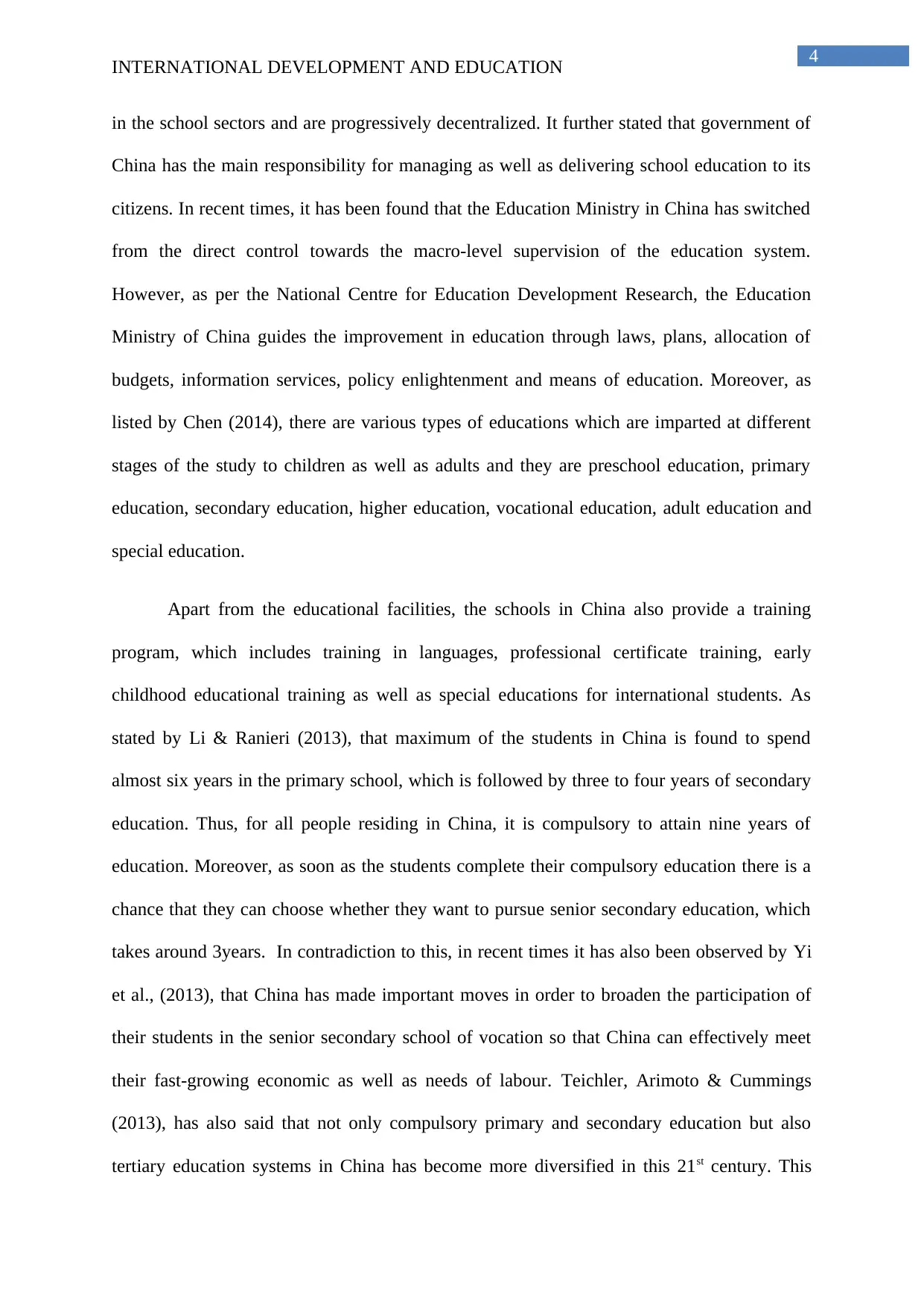
4
INTERNATIONAL DEVELOPMENT AND EDUCATION
in the school sectors and are progressively decentralized. It further stated that government of
China has the main responsibility for managing as well as delivering school education to its
citizens. In recent times, it has been found that the Education Ministry in China has switched
from the direct control towards the macro-level supervision of the education system.
However, as per the National Centre for Education Development Research, the Education
Ministry of China guides the improvement in education through laws, plans, allocation of
budgets, information services, policy enlightenment and means of education. Moreover, as
listed by Chen (2014), there are various types of educations which are imparted at different
stages of the study to children as well as adults and they are preschool education, primary
education, secondary education, higher education, vocational education, adult education and
special education.
Apart from the educational facilities, the schools in China also provide a training
program, which includes training in languages, professional certificate training, early
childhood educational training as well as special educations for international students. As
stated by Li & Ranieri (2013), that maximum of the students in China is found to spend
almost six years in the primary school, which is followed by three to four years of secondary
education. Thus, for all people residing in China, it is compulsory to attain nine years of
education. Moreover, as soon as the students complete their compulsory education there is a
chance that they can choose whether they want to pursue senior secondary education, which
takes around 3years. In contradiction to this, in recent times it has also been observed by Yi
et al., (2013), that China has made important moves in order to broaden the participation of
their students in the senior secondary school of vocation so that China can effectively meet
their fast-growing economic as well as needs of labour. Teichler, Arimoto & Cummings
(2013), has also said that not only compulsory primary and secondary education but also
tertiary education systems in China has become more diversified in this 21st century. This
INTERNATIONAL DEVELOPMENT AND EDUCATION
in the school sectors and are progressively decentralized. It further stated that government of
China has the main responsibility for managing as well as delivering school education to its
citizens. In recent times, it has been found that the Education Ministry in China has switched
from the direct control towards the macro-level supervision of the education system.
However, as per the National Centre for Education Development Research, the Education
Ministry of China guides the improvement in education through laws, plans, allocation of
budgets, information services, policy enlightenment and means of education. Moreover, as
listed by Chen (2014), there are various types of educations which are imparted at different
stages of the study to children as well as adults and they are preschool education, primary
education, secondary education, higher education, vocational education, adult education and
special education.
Apart from the educational facilities, the schools in China also provide a training
program, which includes training in languages, professional certificate training, early
childhood educational training as well as special educations for international students. As
stated by Li & Ranieri (2013), that maximum of the students in China is found to spend
almost six years in the primary school, which is followed by three to four years of secondary
education. Thus, for all people residing in China, it is compulsory to attain nine years of
education. Moreover, as soon as the students complete their compulsory education there is a
chance that they can choose whether they want to pursue senior secondary education, which
takes around 3years. In contradiction to this, in recent times it has also been observed by Yi
et al., (2013), that China has made important moves in order to broaden the participation of
their students in the senior secondary school of vocation so that China can effectively meet
their fast-growing economic as well as needs of labour. Teichler, Arimoto & Cummings
(2013), has also said that not only compulsory primary and secondary education but also
tertiary education systems in China has become more diversified in this 21st century. This
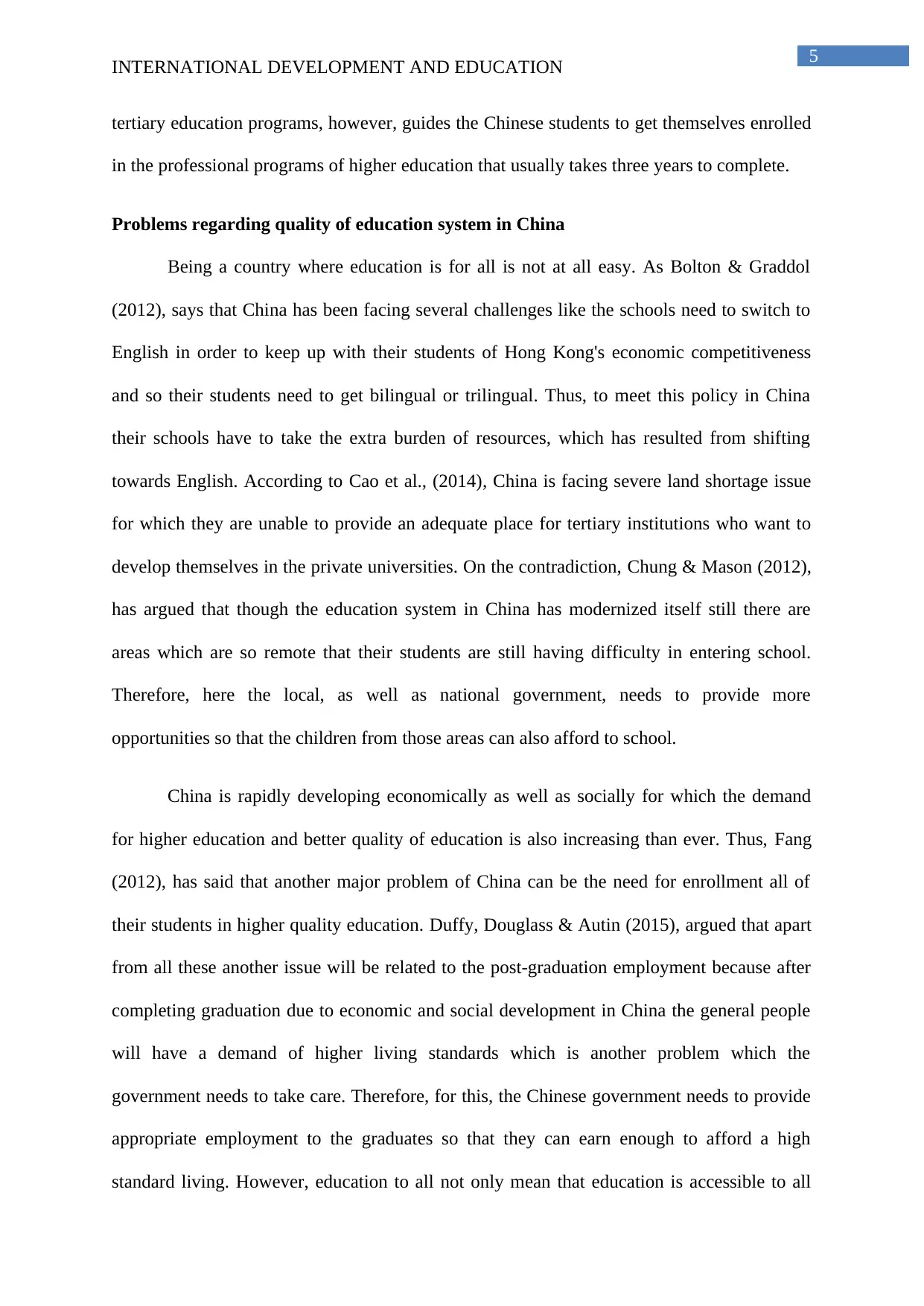
5
INTERNATIONAL DEVELOPMENT AND EDUCATION
tertiary education programs, however, guides the Chinese students to get themselves enrolled
in the professional programs of higher education that usually takes three years to complete.
Problems regarding quality of education system in China
Being a country where education is for all is not at all easy. As Bolton & Graddol
(2012), says that China has been facing several challenges like the schools need to switch to
English in order to keep up with their students of Hong Kong's economic competitiveness
and so their students need to get bilingual or trilingual. Thus, to meet this policy in China
their schools have to take the extra burden of resources, which has resulted from shifting
towards English. According to Cao et al., (2014), China is facing severe land shortage issue
for which they are unable to provide an adequate place for tertiary institutions who want to
develop themselves in the private universities. On the contradiction, Chung & Mason (2012),
has argued that though the education system in China has modernized itself still there are
areas which are so remote that their students are still having difficulty in entering school.
Therefore, here the local, as well as national government, needs to provide more
opportunities so that the children from those areas can also afford to school.
China is rapidly developing economically as well as socially for which the demand
for higher education and better quality of education is also increasing than ever. Thus, Fang
(2012), has said that another major problem of China can be the need for enrollment all of
their students in higher quality education. Duffy, Douglass & Autin (2015), argued that apart
from all these another issue will be related to the post-graduation employment because after
completing graduation due to economic and social development in China the general people
will have a demand of higher living standards which is another problem which the
government needs to take care. Therefore, for this, the Chinese government needs to provide
appropriate employment to the graduates so that they can earn enough to afford a high
standard living. However, education to all not only mean that education is accessible to all
INTERNATIONAL DEVELOPMENT AND EDUCATION
tertiary education programs, however, guides the Chinese students to get themselves enrolled
in the professional programs of higher education that usually takes three years to complete.
Problems regarding quality of education system in China
Being a country where education is for all is not at all easy. As Bolton & Graddol
(2012), says that China has been facing several challenges like the schools need to switch to
English in order to keep up with their students of Hong Kong's economic competitiveness
and so their students need to get bilingual or trilingual. Thus, to meet this policy in China
their schools have to take the extra burden of resources, which has resulted from shifting
towards English. According to Cao et al., (2014), China is facing severe land shortage issue
for which they are unable to provide an adequate place for tertiary institutions who want to
develop themselves in the private universities. On the contradiction, Chung & Mason (2012),
has argued that though the education system in China has modernized itself still there are
areas which are so remote that their students are still having difficulty in entering school.
Therefore, here the local, as well as national government, needs to provide more
opportunities so that the children from those areas can also afford to school.
China is rapidly developing economically as well as socially for which the demand
for higher education and better quality of education is also increasing than ever. Thus, Fang
(2012), has said that another major problem of China can be the need for enrollment all of
their students in higher quality education. Duffy, Douglass & Autin (2015), argued that apart
from all these another issue will be related to the post-graduation employment because after
completing graduation due to economic and social development in China the general people
will have a demand of higher living standards which is another problem which the
government needs to take care. Therefore, for this, the Chinese government needs to provide
appropriate employment to the graduates so that they can earn enough to afford a high
standard living. However, education to all not only mean that education is accessible to all
⊘ This is a preview!⊘
Do you want full access?
Subscribe today to unlock all pages.

Trusted by 1+ million students worldwide
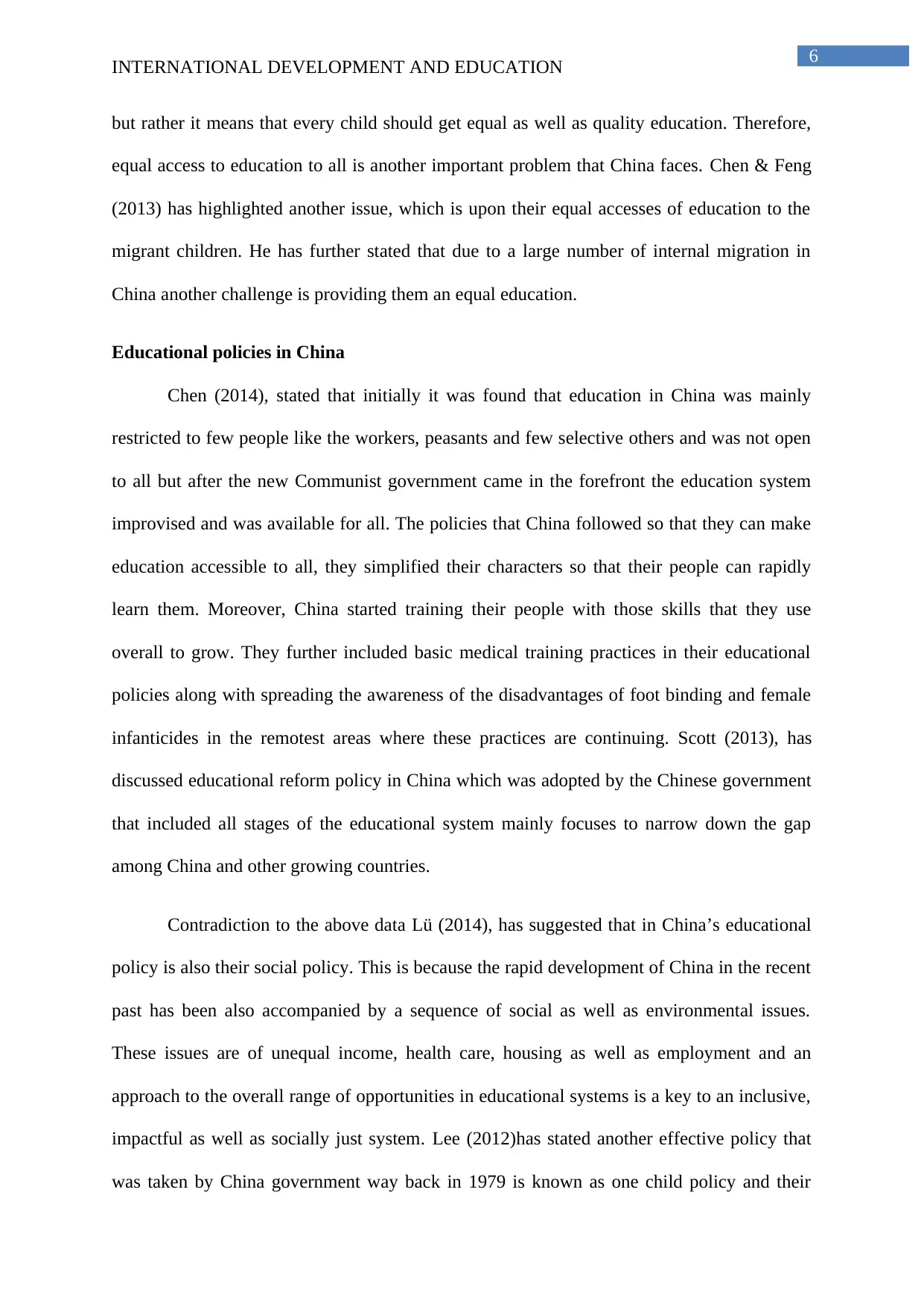
6
INTERNATIONAL DEVELOPMENT AND EDUCATION
but rather it means that every child should get equal as well as quality education. Therefore,
equal access to education to all is another important problem that China faces. Chen & Feng
(2013) has highlighted another issue, which is upon their equal accesses of education to the
migrant children. He has further stated that due to a large number of internal migration in
China another challenge is providing them an equal education.
Educational policies in China
Chen (2014), stated that initially it was found that education in China was mainly
restricted to few people like the workers, peasants and few selective others and was not open
to all but after the new Communist government came in the forefront the education system
improvised and was available for all. The policies that China followed so that they can make
education accessible to all, they simplified their characters so that their people can rapidly
learn them. Moreover, China started training their people with those skills that they use
overall to grow. They further included basic medical training practices in their educational
policies along with spreading the awareness of the disadvantages of foot binding and female
infanticides in the remotest areas where these practices are continuing. Scott (2013), has
discussed educational reform policy in China which was adopted by the Chinese government
that included all stages of the educational system mainly focuses to narrow down the gap
among China and other growing countries.
Contradiction to the above data Lü (2014), has suggested that in China’s educational
policy is also their social policy. This is because the rapid development of China in the recent
past has been also accompanied by a sequence of social as well as environmental issues.
These issues are of unequal income, health care, housing as well as employment and an
approach to the overall range of opportunities in educational systems is a key to an inclusive,
impactful as well as socially just system. Lee (2012)has stated another effective policy that
was taken by China government way back in 1979 is known as one child policy and their
INTERNATIONAL DEVELOPMENT AND EDUCATION
but rather it means that every child should get equal as well as quality education. Therefore,
equal access to education to all is another important problem that China faces. Chen & Feng
(2013) has highlighted another issue, which is upon their equal accesses of education to the
migrant children. He has further stated that due to a large number of internal migration in
China another challenge is providing them an equal education.
Educational policies in China
Chen (2014), stated that initially it was found that education in China was mainly
restricted to few people like the workers, peasants and few selective others and was not open
to all but after the new Communist government came in the forefront the education system
improvised and was available for all. The policies that China followed so that they can make
education accessible to all, they simplified their characters so that their people can rapidly
learn them. Moreover, China started training their people with those skills that they use
overall to grow. They further included basic medical training practices in their educational
policies along with spreading the awareness of the disadvantages of foot binding and female
infanticides in the remotest areas where these practices are continuing. Scott (2013), has
discussed educational reform policy in China which was adopted by the Chinese government
that included all stages of the educational system mainly focuses to narrow down the gap
among China and other growing countries.
Contradiction to the above data Lü (2014), has suggested that in China’s educational
policy is also their social policy. This is because the rapid development of China in the recent
past has been also accompanied by a sequence of social as well as environmental issues.
These issues are of unequal income, health care, housing as well as employment and an
approach to the overall range of opportunities in educational systems is a key to an inclusive,
impactful as well as socially just system. Lee (2012)has stated another effective policy that
was taken by China government way back in 1979 is known as one child policy and their
Paraphrase This Document
Need a fresh take? Get an instant paraphrase of this document with our AI Paraphraser
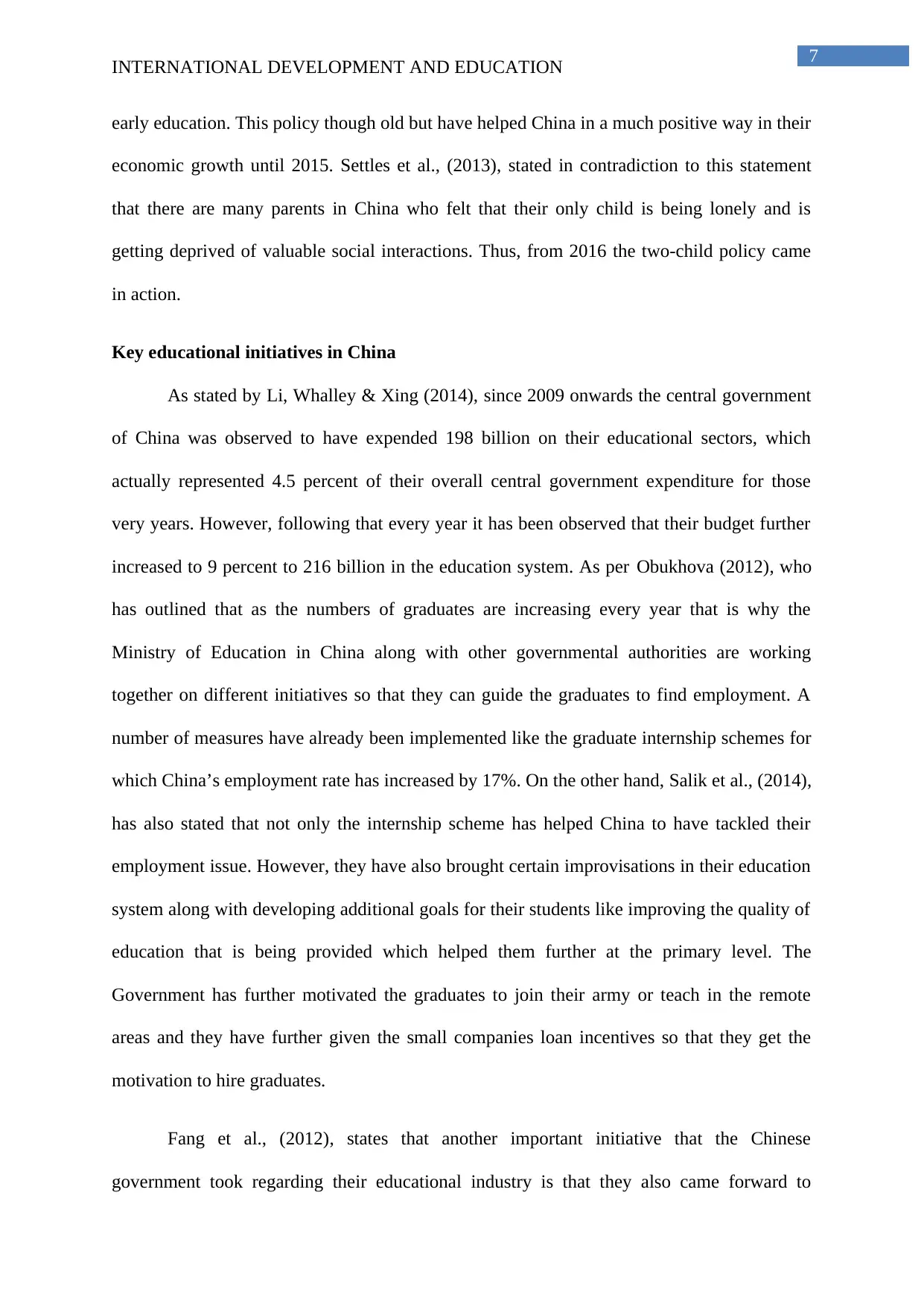
7
INTERNATIONAL DEVELOPMENT AND EDUCATION
early education. This policy though old but have helped China in a much positive way in their
economic growth until 2015. Settles et al., (2013), stated in contradiction to this statement
that there are many parents in China who felt that their only child is being lonely and is
getting deprived of valuable social interactions. Thus, from 2016 the two-child policy came
in action.
Key educational initiatives in China
As stated by Li, Whalley & Xing (2014), since 2009 onwards the central government
of China was observed to have expended 198 billion on their educational sectors, which
actually represented 4.5 percent of their overall central government expenditure for those
very years. However, following that every year it has been observed that their budget further
increased to 9 percent to 216 billion in the education system. As per Obukhova (2012), who
has outlined that as the numbers of graduates are increasing every year that is why the
Ministry of Education in China along with other governmental authorities are working
together on different initiatives so that they can guide the graduates to find employment. A
number of measures have already been implemented like the graduate internship schemes for
which China’s employment rate has increased by 17%. On the other hand, Salik et al., (2014),
has also stated that not only the internship scheme has helped China to have tackled their
employment issue. However, they have also brought certain improvisations in their education
system along with developing additional goals for their students like improving the quality of
education that is being provided which helped them further at the primary level. The
Government has further motivated the graduates to join their army or teach in the remote
areas and they have further given the small companies loan incentives so that they get the
motivation to hire graduates.
Fang et al., (2012), states that another important initiative that the Chinese
government took regarding their educational industry is that they also came forward to
INTERNATIONAL DEVELOPMENT AND EDUCATION
early education. This policy though old but have helped China in a much positive way in their
economic growth until 2015. Settles et al., (2013), stated in contradiction to this statement
that there are many parents in China who felt that their only child is being lonely and is
getting deprived of valuable social interactions. Thus, from 2016 the two-child policy came
in action.
Key educational initiatives in China
As stated by Li, Whalley & Xing (2014), since 2009 onwards the central government
of China was observed to have expended 198 billion on their educational sectors, which
actually represented 4.5 percent of their overall central government expenditure for those
very years. However, following that every year it has been observed that their budget further
increased to 9 percent to 216 billion in the education system. As per Obukhova (2012), who
has outlined that as the numbers of graduates are increasing every year that is why the
Ministry of Education in China along with other governmental authorities are working
together on different initiatives so that they can guide the graduates to find employment. A
number of measures have already been implemented like the graduate internship schemes for
which China’s employment rate has increased by 17%. On the other hand, Salik et al., (2014),
has also stated that not only the internship scheme has helped China to have tackled their
employment issue. However, they have also brought certain improvisations in their education
system along with developing additional goals for their students like improving the quality of
education that is being provided which helped them further at the primary level. The
Government has further motivated the graduates to join their army or teach in the remote
areas and they have further given the small companies loan incentives so that they get the
motivation to hire graduates.
Fang et al., (2012), states that another important initiative that the Chinese
government took regarding their educational industry is that they also came forward to
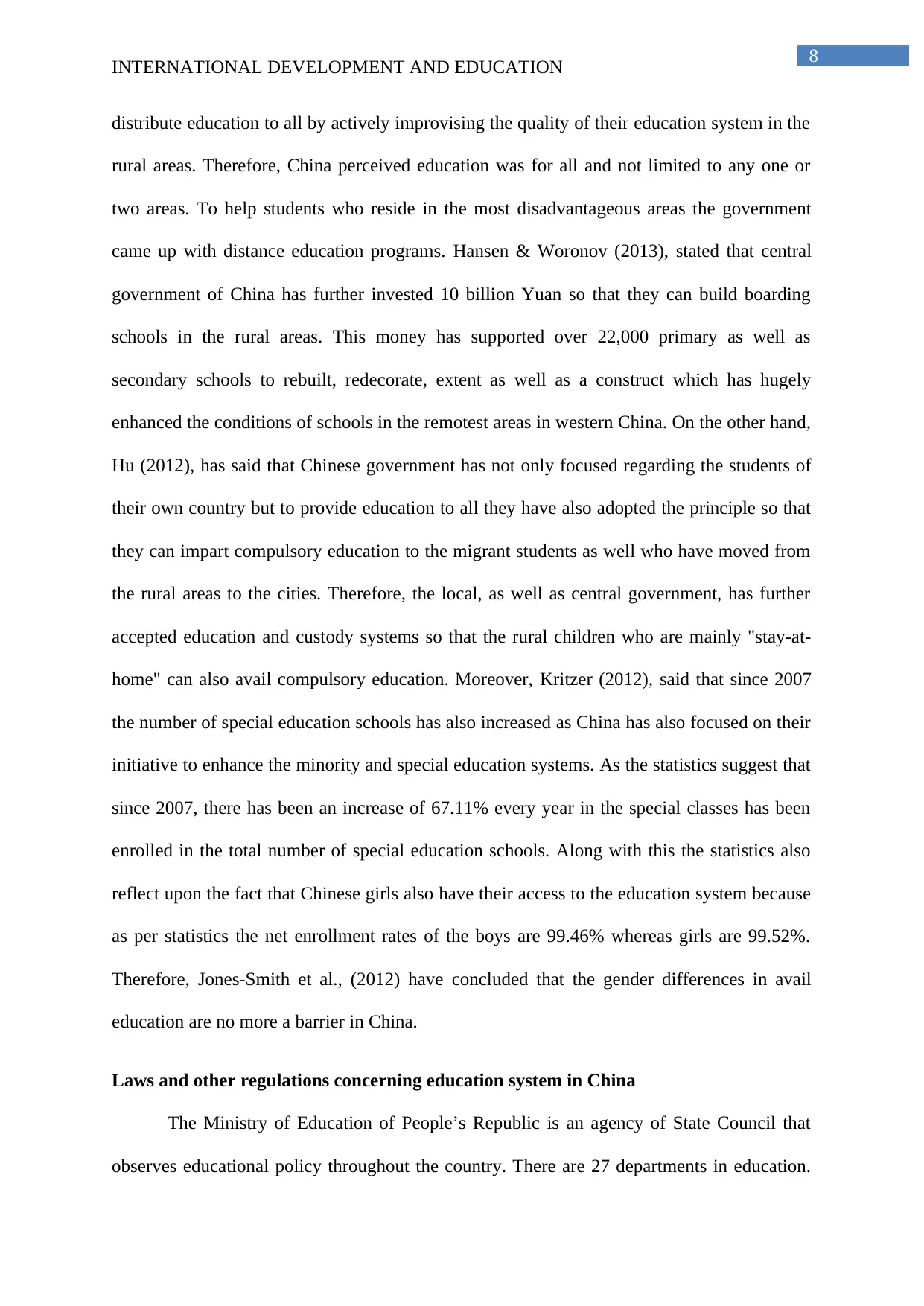
8
INTERNATIONAL DEVELOPMENT AND EDUCATION
distribute education to all by actively improvising the quality of their education system in the
rural areas. Therefore, China perceived education was for all and not limited to any one or
two areas. To help students who reside in the most disadvantageous areas the government
came up with distance education programs. Hansen & Woronov (2013), stated that central
government of China has further invested 10 billion Yuan so that they can build boarding
schools in the rural areas. This money has supported over 22,000 primary as well as
secondary schools to rebuilt, redecorate, extent as well as a construct which has hugely
enhanced the conditions of schools in the remotest areas in western China. On the other hand,
Hu (2012), has said that Chinese government has not only focused regarding the students of
their own country but to provide education to all they have also adopted the principle so that
they can impart compulsory education to the migrant students as well who have moved from
the rural areas to the cities. Therefore, the local, as well as central government, has further
accepted education and custody systems so that the rural children who are mainly "stay-at-
home" can also avail compulsory education. Moreover, Kritzer (2012), said that since 2007
the number of special education schools has also increased as China has also focused on their
initiative to enhance the minority and special education systems. As the statistics suggest that
since 2007, there has been an increase of 67.11% every year in the special classes has been
enrolled in the total number of special education schools. Along with this the statistics also
reflect upon the fact that Chinese girls also have their access to the education system because
as per statistics the net enrollment rates of the boys are 99.46% whereas girls are 99.52%.
Therefore, Jones-Smith et al., (2012) have concluded that the gender differences in avail
education are no more a barrier in China.
Laws and other regulations concerning education system in China
The Ministry of Education of People’s Republic is an agency of State Council that
observes educational policy throughout the country. There are 27 departments in education.
INTERNATIONAL DEVELOPMENT AND EDUCATION
distribute education to all by actively improvising the quality of their education system in the
rural areas. Therefore, China perceived education was for all and not limited to any one or
two areas. To help students who reside in the most disadvantageous areas the government
came up with distance education programs. Hansen & Woronov (2013), stated that central
government of China has further invested 10 billion Yuan so that they can build boarding
schools in the rural areas. This money has supported over 22,000 primary as well as
secondary schools to rebuilt, redecorate, extent as well as a construct which has hugely
enhanced the conditions of schools in the remotest areas in western China. On the other hand,
Hu (2012), has said that Chinese government has not only focused regarding the students of
their own country but to provide education to all they have also adopted the principle so that
they can impart compulsory education to the migrant students as well who have moved from
the rural areas to the cities. Therefore, the local, as well as central government, has further
accepted education and custody systems so that the rural children who are mainly "stay-at-
home" can also avail compulsory education. Moreover, Kritzer (2012), said that since 2007
the number of special education schools has also increased as China has also focused on their
initiative to enhance the minority and special education systems. As the statistics suggest that
since 2007, there has been an increase of 67.11% every year in the special classes has been
enrolled in the total number of special education schools. Along with this the statistics also
reflect upon the fact that Chinese girls also have their access to the education system because
as per statistics the net enrollment rates of the boys are 99.46% whereas girls are 99.52%.
Therefore, Jones-Smith et al., (2012) have concluded that the gender differences in avail
education are no more a barrier in China.
Laws and other regulations concerning education system in China
The Ministry of Education of People’s Republic is an agency of State Council that
observes educational policy throughout the country. There are 27 departments in education.
⊘ This is a preview!⊘
Do you want full access?
Subscribe today to unlock all pages.

Trusted by 1+ million students worldwide
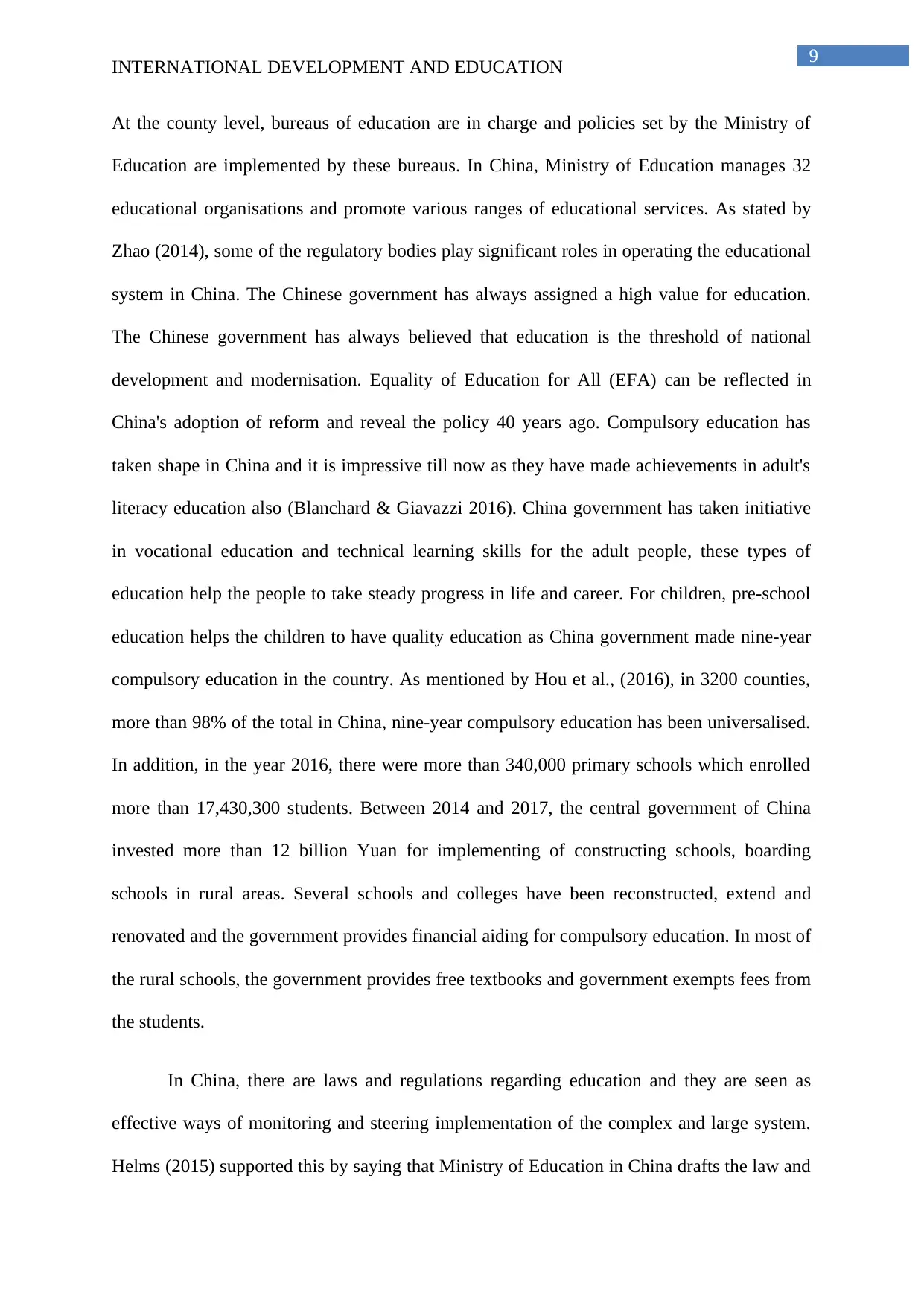
9
INTERNATIONAL DEVELOPMENT AND EDUCATION
At the county level, bureaus of education are in charge and policies set by the Ministry of
Education are implemented by these bureaus. In China, Ministry of Education manages 32
educational organisations and promote various ranges of educational services. As stated by
Zhao (2014), some of the regulatory bodies play significant roles in operating the educational
system in China. The Chinese government has always assigned a high value for education.
The Chinese government has always believed that education is the threshold of national
development and modernisation. Equality of Education for All (EFA) can be reflected in
China's adoption of reform and reveal the policy 40 years ago. Compulsory education has
taken shape in China and it is impressive till now as they have made achievements in adult's
literacy education also (Blanchard & Giavazzi 2016). China government has taken initiative
in vocational education and technical learning skills for the adult people, these types of
education help the people to take steady progress in life and career. For children, pre-school
education helps the children to have quality education as China government made nine-year
compulsory education in the country. As mentioned by Hou et al., (2016), in 3200 counties,
more than 98% of the total in China, nine-year compulsory education has been universalised.
In addition, in the year 2016, there were more than 340,000 primary schools which enrolled
more than 17,430,300 students. Between 2014 and 2017, the central government of China
invested more than 12 billion Yuan for implementing of constructing schools, boarding
schools in rural areas. Several schools and colleges have been reconstructed, extend and
renovated and the government provides financial aiding for compulsory education. In most of
the rural schools, the government provides free textbooks and government exempts fees from
the students.
In China, there are laws and regulations regarding education and they are seen as
effective ways of monitoring and steering implementation of the complex and large system.
Helms (2015) supported this by saying that Ministry of Education in China drafts the law and
INTERNATIONAL DEVELOPMENT AND EDUCATION
At the county level, bureaus of education are in charge and policies set by the Ministry of
Education are implemented by these bureaus. In China, Ministry of Education manages 32
educational organisations and promote various ranges of educational services. As stated by
Zhao (2014), some of the regulatory bodies play significant roles in operating the educational
system in China. The Chinese government has always assigned a high value for education.
The Chinese government has always believed that education is the threshold of national
development and modernisation. Equality of Education for All (EFA) can be reflected in
China's adoption of reform and reveal the policy 40 years ago. Compulsory education has
taken shape in China and it is impressive till now as they have made achievements in adult's
literacy education also (Blanchard & Giavazzi 2016). China government has taken initiative
in vocational education and technical learning skills for the adult people, these types of
education help the people to take steady progress in life and career. For children, pre-school
education helps the children to have quality education as China government made nine-year
compulsory education in the country. As mentioned by Hou et al., (2016), in 3200 counties,
more than 98% of the total in China, nine-year compulsory education has been universalised.
In addition, in the year 2016, there were more than 340,000 primary schools which enrolled
more than 17,430,300 students. Between 2014 and 2017, the central government of China
invested more than 12 billion Yuan for implementing of constructing schools, boarding
schools in rural areas. Several schools and colleges have been reconstructed, extend and
renovated and the government provides financial aiding for compulsory education. In most of
the rural schools, the government provides free textbooks and government exempts fees from
the students.
In China, there are laws and regulations regarding education and they are seen as
effective ways of monitoring and steering implementation of the complex and large system.
Helms (2015) supported this by saying that Ministry of Education in China drafts the law and
Paraphrase This Document
Need a fresh take? Get an instant paraphrase of this document with our AI Paraphraser
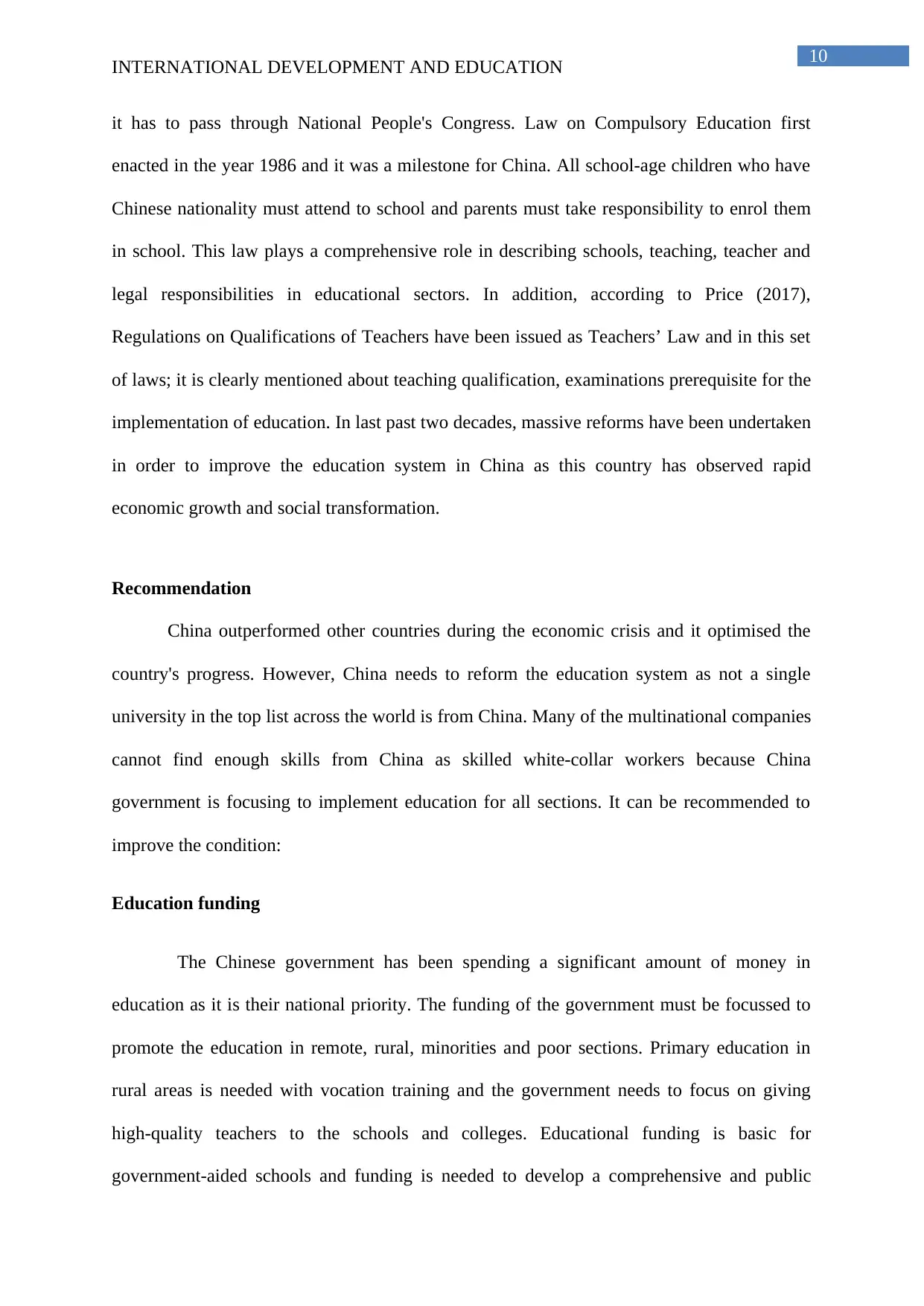
10
INTERNATIONAL DEVELOPMENT AND EDUCATION
it has to pass through National People's Congress. Law on Compulsory Education first
enacted in the year 1986 and it was a milestone for China. All school-age children who have
Chinese nationality must attend to school and parents must take responsibility to enrol them
in school. This law plays a comprehensive role in describing schools, teaching, teacher and
legal responsibilities in educational sectors. In addition, according to Price (2017),
Regulations on Qualifications of Teachers have been issued as Teachers’ Law and in this set
of laws; it is clearly mentioned about teaching qualification, examinations prerequisite for the
implementation of education. In last past two decades, massive reforms have been undertaken
in order to improve the education system in China as this country has observed rapid
economic growth and social transformation.
Recommendation
China outperformed other countries during the economic crisis and it optimised the
country's progress. However, China needs to reform the education system as not a single
university in the top list across the world is from China. Many of the multinational companies
cannot find enough skills from China as skilled white-collar workers because China
government is focusing to implement education for all sections. It can be recommended to
improve the condition:
Education funding
The Chinese government has been spending a significant amount of money in
education as it is their national priority. The funding of the government must be focussed to
promote the education in remote, rural, minorities and poor sections. Primary education in
rural areas is needed with vocation training and the government needs to focus on giving
high-quality teachers to the schools and colleges. Educational funding is basic for
government-aided schools and funding is needed to develop a comprehensive and public
INTERNATIONAL DEVELOPMENT AND EDUCATION
it has to pass through National People's Congress. Law on Compulsory Education first
enacted in the year 1986 and it was a milestone for China. All school-age children who have
Chinese nationality must attend to school and parents must take responsibility to enrol them
in school. This law plays a comprehensive role in describing schools, teaching, teacher and
legal responsibilities in educational sectors. In addition, according to Price (2017),
Regulations on Qualifications of Teachers have been issued as Teachers’ Law and in this set
of laws; it is clearly mentioned about teaching qualification, examinations prerequisite for the
implementation of education. In last past two decades, massive reforms have been undertaken
in order to improve the education system in China as this country has observed rapid
economic growth and social transformation.
Recommendation
China outperformed other countries during the economic crisis and it optimised the
country's progress. However, China needs to reform the education system as not a single
university in the top list across the world is from China. Many of the multinational companies
cannot find enough skills from China as skilled white-collar workers because China
government is focusing to implement education for all sections. It can be recommended to
improve the condition:
Education funding
The Chinese government has been spending a significant amount of money in
education as it is their national priority. The funding of the government must be focussed to
promote the education in remote, rural, minorities and poor sections. Primary education in
rural areas is needed with vocation training and the government needs to focus on giving
high-quality teachers to the schools and colleges. Educational funding is basic for
government-aided schools and funding is needed to develop a comprehensive and public
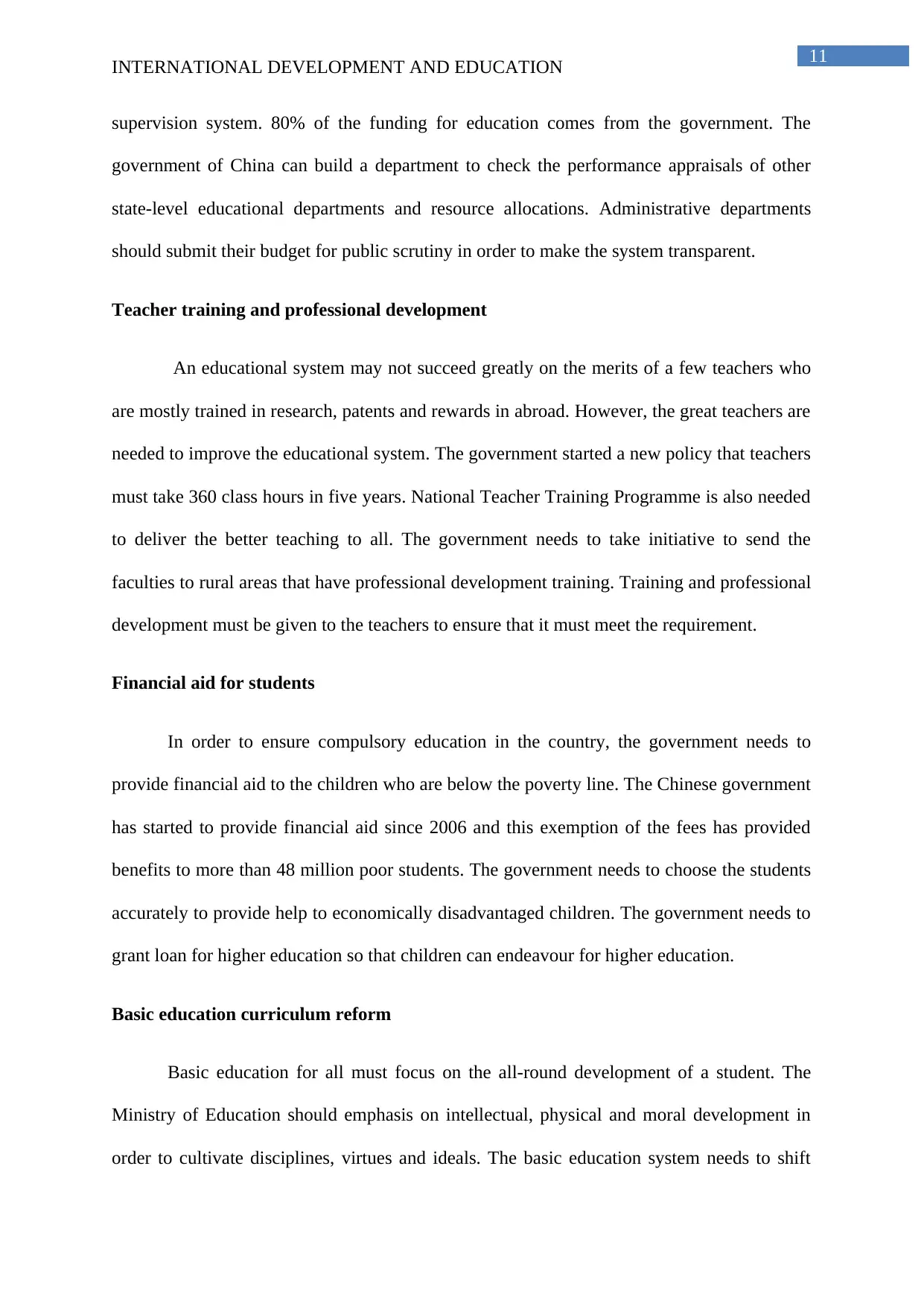
11
INTERNATIONAL DEVELOPMENT AND EDUCATION
supervision system. 80% of the funding for education comes from the government. The
government of China can build a department to check the performance appraisals of other
state-level educational departments and resource allocations. Administrative departments
should submit their budget for public scrutiny in order to make the system transparent.
Teacher training and professional development
An educational system may not succeed greatly on the merits of a few teachers who
are mostly trained in research, patents and rewards in abroad. However, the great teachers are
needed to improve the educational system. The government started a new policy that teachers
must take 360 class hours in five years. National Teacher Training Programme is also needed
to deliver the better teaching to all. The government needs to take initiative to send the
faculties to rural areas that have professional development training. Training and professional
development must be given to the teachers to ensure that it must meet the requirement.
Financial aid for students
In order to ensure compulsory education in the country, the government needs to
provide financial aid to the children who are below the poverty line. The Chinese government
has started to provide financial aid since 2006 and this exemption of the fees has provided
benefits to more than 48 million poor students. The government needs to choose the students
accurately to provide help to economically disadvantaged children. The government needs to
grant loan for higher education so that children can endeavour for higher education.
Basic education curriculum reform
Basic education for all must focus on the all-round development of a student. The
Ministry of Education should emphasis on intellectual, physical and moral development in
order to cultivate disciplines, virtues and ideals. The basic education system needs to shift
INTERNATIONAL DEVELOPMENT AND EDUCATION
supervision system. 80% of the funding for education comes from the government. The
government of China can build a department to check the performance appraisals of other
state-level educational departments and resource allocations. Administrative departments
should submit their budget for public scrutiny in order to make the system transparent.
Teacher training and professional development
An educational system may not succeed greatly on the merits of a few teachers who
are mostly trained in research, patents and rewards in abroad. However, the great teachers are
needed to improve the educational system. The government started a new policy that teachers
must take 360 class hours in five years. National Teacher Training Programme is also needed
to deliver the better teaching to all. The government needs to take initiative to send the
faculties to rural areas that have professional development training. Training and professional
development must be given to the teachers to ensure that it must meet the requirement.
Financial aid for students
In order to ensure compulsory education in the country, the government needs to
provide financial aid to the children who are below the poverty line. The Chinese government
has started to provide financial aid since 2006 and this exemption of the fees has provided
benefits to more than 48 million poor students. The government needs to choose the students
accurately to provide help to economically disadvantaged children. The government needs to
grant loan for higher education so that children can endeavour for higher education.
Basic education curriculum reform
Basic education for all must focus on the all-round development of a student. The
Ministry of Education should emphasis on intellectual, physical and moral development in
order to cultivate disciplines, virtues and ideals. The basic education system needs to shift
⊘ This is a preview!⊘
Do you want full access?
Subscribe today to unlock all pages.

Trusted by 1+ million students worldwide
1 out of 17
Related Documents
Your All-in-One AI-Powered Toolkit for Academic Success.
+13062052269
info@desklib.com
Available 24*7 on WhatsApp / Email
![[object Object]](/_next/static/media/star-bottom.7253800d.svg)
Unlock your academic potential
Copyright © 2020–2025 A2Z Services. All Rights Reserved. Developed and managed by ZUCOL.





